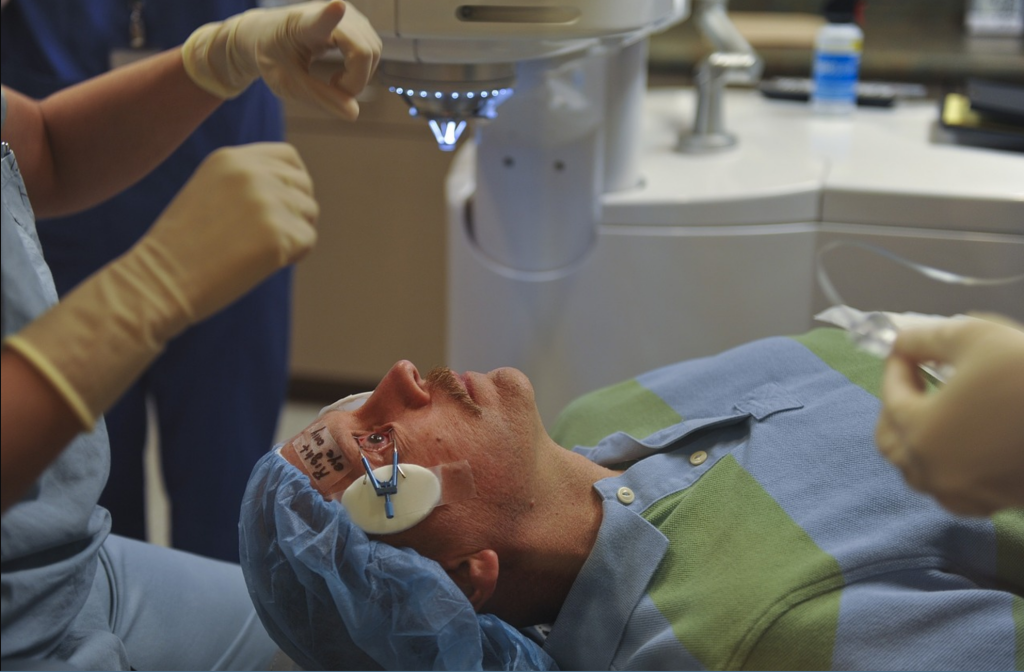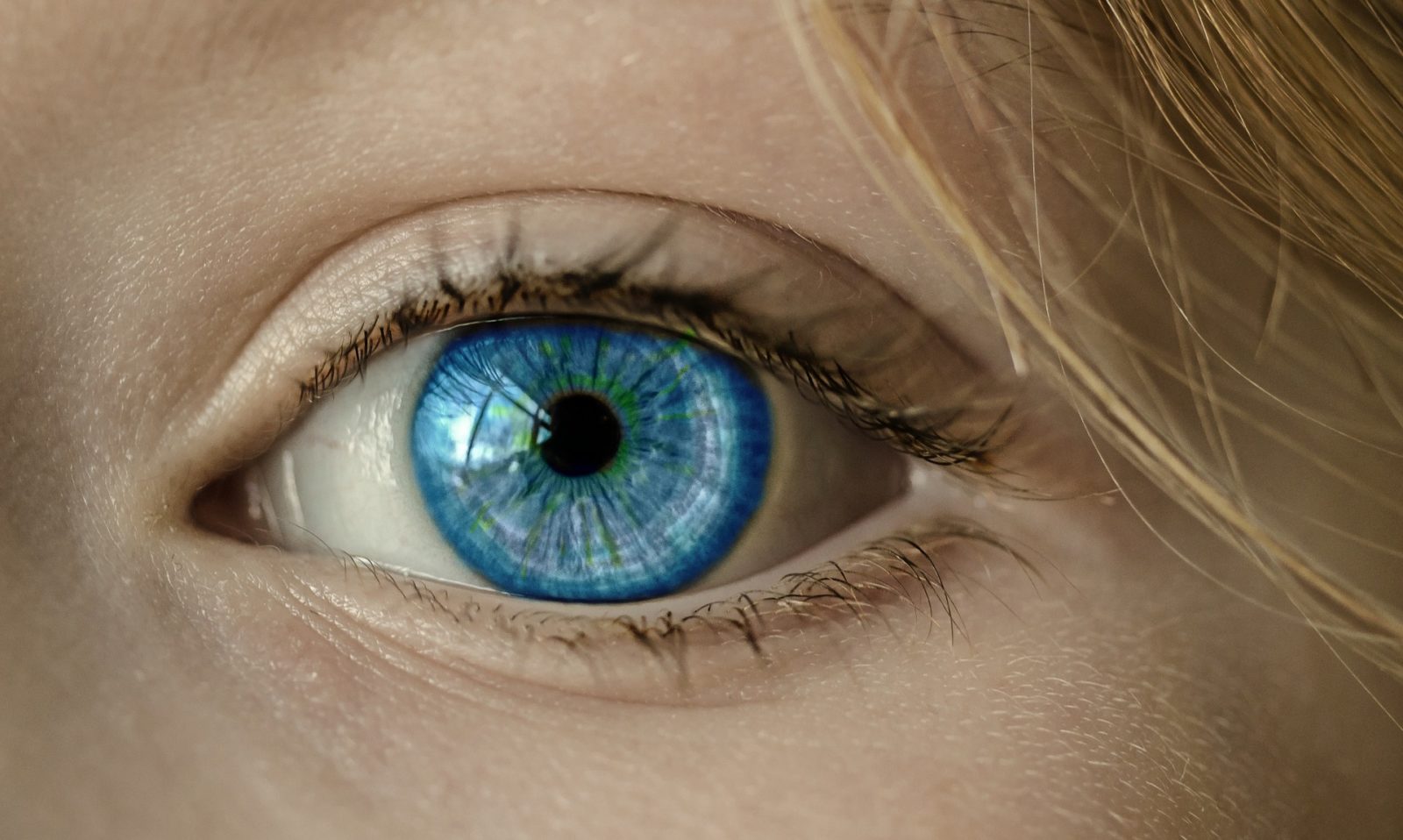Vision is a wonderful thing. Glasses and contacts alike can be expensive, with vision changing and style, the bills will add up over time one may sometimes consider whether or not LASIK surgery is right for them. Discover the ins and outs of this eye surgery as well as what you can do at home with diet and lifestyle to improve eyesight.
LASIK
LASIK, also known as laser in situ keratomileuses or laser vision correction has been used by Optometrists and Ophthalmologists since 1991. The procedure was developed by Greek doctor Ioannis Pallikaris and as of 2012, it has been used on more than 17 million individuals worldwide (Matthews, 2012).
The goal or purpose of this procedure is to decrease/eliminate the dependency on glasses or contacts by allowing more light to be focused on the retina (Turner, 2011). This is all dependent on the size and shape of both the eyeball and the cornea as well as the strength of the eye’s natural lens (Zeiss, 2006). There are limitations or restrictions for LASIK, such as not being able to change the close-up focusing power of eyes that have been touched with presbyopia, an age-related loss of eyesight. However, for the most part, it has been a very successful alternative treatment for improving eye care (AAofO, 2008).
Anatomy of the Eye & its Dysfunction
Our eyes provide us with a sense of vision. They allow us to experience our surroundings and through the images, we send our brain we are able to keep visual memories. The eyeball is a hollow, fluid-filled (humor) sphere composed of three distinct layers. The layers include;
- Fibrous layer: which is the outer protective layer of the eye consisting of the sclera (white connective tissue) and the cornea (composed of nerve endings, though it is susceptible to damage, it lacks blood vessels – making it devoid of the immune system and allowing it to be easily replaced by a donor cornea).
- Vascular layer: the middle layer of the eye is filled with blood vessels, it is composed of the iris and pupil.
- Sensory layer: the innermost layer of the eye contains the retina, a pigmented layer, a neural layer as well as optic nerves.
In order to have a clear vision, the cornea and the natural lens of the eye need to refract rays of light at the perfect angle in order to focus a clear image on the retina. The natural lens of the eye can adjust itself in order to better angle light into the eye, however, the cornea is stationary.
The cornea is part of the fibrous layer of the eye and consists with five thin layers, which are all required to provide a clear visible image for the retina. The primary layer is the stroma which provides the structural shape and reflective power for the stroma (Turner, 2011).
When an eye focuses images correctly it means that it has emmetropia. There are three forms of eyesight deterioration.
Myopia: Is the technical term for nearsightedness. The light that is refracted into the retina instead of reaching it as it naturally should the light begins to focus prior to reaching its destination at the retina. This is due either to the increased curvature of the cornea, a longer shaped eyeball or that the natural lens of the eye is too strong.
Hyperopia: This occurs when the light from distant objects is brought into focus behind the retina instead of directly at it. This is either due to one’s eyeball being too short or the lens being too weak. The cornea is also a great deal flatter. All of these issues combined or separate lead to an individual being farsighted.
Astigmatism: Is a result of unequal curvature in either or both the cornea and eyes’ natural lens. The blurry image that the brain is provided as a result of the cornea and the lens providing instead of points of light, lines of light for the retina.
(Turner, 2011) (Zeiss, 2006) (Marieb, 2012)
LASIK Candidacy
Prior to the surgery, your optometrist or ophthalmologist will go over your health history as well as other aspects of your life to see if you will be a viable candidate for LASIK eye surgery. Below are a few reasons one may not be the best candidate for LASIK:
- History of herpes
- Diabetic – the procedure is risky
- Glaucoma (if the eyes have been stable for a few years the surgery may still be possible)
- Severe allergies
- If the individual is younger than 21 years it is recommended that they do not do the surgery
- If the individual is too old or if one’s vision is too weak the surgery is not recommended
- Refractions – one’s eye prescription (if stable for one year the surgery may be possible)
- Cornea to thin
- History of keloid formation
- Medication- disclose all medication one is taking as some may interfere with the safety and success of the surgery
- Pregnancy or nursing
- History of ocular disease, problems or injury
- Autoimmune diseases – poor wound healing
- Personal outlook or unrealistic expectations of the surgery
There are a few things in the above list that can be worked out to allow an individual to partake in LASIK. For the most part, if you fall into one of these issues you will not make a good and safe candidate for LASIK surgery.
(Turner, 2011) (Zeiss, 2006) (Steinert, R., et al, n.d.) (Alcon, 2013)
Pre-op Examination, Surgery, and Recovery
The initial examination or pre-op examination should include the following ;
- analysis of the eyes refraction capability
- corneal topography
- assessment of whether the individual has dry eye syndrome
- analysis and measurement of eyes pressure
- a lamp examination of the anterior segment
- dilated pupil fundus examination
This along with an intake of medical history will provide the eye doctor with a good basis for either allowing the individual to become a candidate for LASIK or not.
Individuals considering LASIK surgery will be advised to refrain from using contact lenses for 2 weeks prior to the initial examination and if rigid gas permeable contact lenses are worn 4 weeks is the allotted time these specific contacts should not be worn. Contact lenses have the potential to warp and change the shape of the cornea – such an impact would interfere with properly determining if an individual is a proper candidate for LASIK surgery (Turner, 2011).
If you are a viable candidate for LASIK make sure that you feel comfortable with your surgeon and that they have been practicing/performing successfully LASIK for a few years if not more (Alcon, 2013).
The Surgery
Prior to the surgery refrain from using makeup as well as an eye cream. Make sure that when washing the eyes and face it is done lightly and with a gentle wash. Most importantly make sure that you have someone take you too and from the hospital or surgery center. Also, make sure to bring dark sunglasses with you!

Although you may be at your appointment for a few hours the surgery will only take a few minutes. This is what one can expect during the surgery; (Alcon, 2013)
- The procedure begins with the numbing of the eyeball through the use of drops.
- The surgeon uses a microkeratome to cut a hinged corneal flap – which is pulled back to expose the stroma
- An excimer laser is used to reshape the stroma of the cornea in such a way as to allow better light refraction – this is done uniquely to each and every individual.
- A small amount of stroma tissue is removed if myopia is present and the curvature of the cornea is slightly flattened so as to allow for the greater refractive potential for the eyes – thus providing clearer vision. If hyperopia or astigmatism is the issue the surgeon will make adjustments to the cornea and replace it in such a position so as to allow for the best refractive potential.
- The edges of the corneal flap are smoothed out without the need of stitches, however, the flap will never adhere in strength to the rest of the cornea as it had been prior to the surgery (Matthews, 2012) (Marcos, S et al, 2001) (AAofO, 2008).

Recovery
After the surgery is finished make a follow-up appointment for the next day – it is also beneficial at this point to make a one week follow up as well. On your way home make sure to pick up the prescription medication the doctor has prescribed you and spend the remainder of the day resting (ibid).
Make sure not to rub or irritate your eyes and have someone with you or close at hand for the day. The surgeon will provide you with a transparent protective eye shield that can be placed over the eyes to prevent irritation befalling them during the night. You will also be advised to take a few days off of work so as to rest your eyes and body – proper rest will aid in recovery (Alcon, 2013). One may experience slight discomfort and pain for up to a week after surgery, as well as a sensitivity to light and increased pressure on the eyes. If the procedure was successful this should all go away in about a week’s time (Zeiss, 2006).
You will also be provided with eye drops to prevent the development of infection and reduce inflammation and alleviate dryness. Make sure to follow all the instructions provided to you by your doctor (AAofO, 2008).
It may only take a few days for the cornea to adhere as best as it can onto the eyeball, however, it is very important to make all follow up appointments so that the surgeon can monitor the healing process and see that no damage is occurring to the eyeball. Follow up appointments occur the following day of the surgery, 1 week later, 1 – 3 -6 months later as well as 1 year later (Turner, 2011).
Pros and Cons of LASIK
There is a global average of approximately 95% successful and or satisfied patients of LASIK surgery (Solomon, K.D., et al. 2009) (Turner, 2011). With the screening process being so rigorous there are rarely any risks associated with LASIK – however as with any surgery risks can occur and one must always remember that LASIK cannot always provide perfect vision (Steinert, R., et al, n.d.).
The complications and risks associated with LASIK are as followed;
- Seeing a glare or halo around lights during the night time.
- Under or over correction – this results when the stroma of the cornea is either flattened or curved out too much resulting in a change in eyesight deterioration. This can be corrected with another surgery.
- If there is an abnormal bulging of the corneal flap further surgery will be needed.
- Whether by tearing or touching the eye or perhaps a very poor adhesion the corneal flag may become either wrinkled or hang free.
- Although very rare in occurrence infections can happen – are easily treated
- Inflammation may occur a few days after the surgery. This is a natural occurrence (that may require antibiotics) however, if it persists longer it may have developed into a larger issue.
- One’s vision may have only slightly improved or it may have also become a great deal worse in comparison to how it was prior to the surgery (on very rare occurrences vision loss may occur and be permanent). This will require the individual to wear corrective lenses. Depending on the state of the individual another surgery may be possible to potentially reach a more desirable outcome.
Side effects that are persistent up to six months after surgery:
- Discomfort and pain
- Dry eyes
- Blurry/hazy vision
- Weak night vision
- Sensitivity to light
- Small pink and or red patches on the whites of the eyes
Most complications – though they are very rare in occurrence – such as per example an eye infection, dry eye syndrome and problems with the attachment of the corneal flap can all be fixed by an optometrist (Matthews, 2012). On the whole, LASIK is a safe and effective treatment. Its cost ranges from between $1,500 to $3,500 per eye (ibid).
Though the treatment may improve vision (the best results garnered between 20/20 or 20/40) this surgery will not prevent the individual from experiencing issues with their eyesight and the health of their eyes as they age. It is therefore essential to make sure to take good care of one’s eyes and reduce unnecessary stress and wear on them (Randleman, J.B., 2003).
Strengthening Eye Health Holistically and Naturally
Diet and lifestyle make a big impact on the functionality and health of the body – from the largest to the smallest organs. Your eyes are no different, poor diet and health will lead to poor eye strength, sight, and function.
Consuming a clean, whole foods diet is essential – with local and organic foods as much as possible. Fried and grilled foods are free radical forming. Processed goods and alcohol have the same end result. A high amount of free radical damage in the body puts a strain on the immune system, brings about more inflammation and over time may result in damage and degeneration to the eyes.

There are many types of foods that can be eaten that aid in developing and keeping healthy eye function. These foods include the following;
- Yellow and green vegetables.
- Tomatoes, in their varying forms, have been shown to be very beneficial for eye health – unprocessed
- Carrots are high in beta-carotene which is amazingly beneficial for eye health. High in antioxidants, carrots also aid in fighting off free radical damage
- Berries rich in the secondary compound flavonoid such as blackberries, blueberries, raspberries – cherries are also rich in flavonoids
- Local and organic fruits and vegetables – one wants to eat seasonally so as to accumulate the highest amount of nutrients from the food.
- Nuts and fish are also very beneficial (make such to make a sustainable and wise choice when selecting fish) – they are both rich in beneficial fatty acids
- If one does already drink – a small amount of red wine is beneficial – if you don’t drink don’t start.

There are many supplements that can be taken that aid in supporting eye function and health. I for one have found that a good diet and supplementation have aided my eyesight greatly. For the past seven years, my eyesight has not changed – this makes me incredibly happy. Supplements that aid in retaining and enforcing eye health and function include the following below. They should be incorporated into the daily lifestyle and if the adequate amount can be derived from a food source that would be best.
- A high potency multi-vitamin such as Truehope multivitamins or Progressive Multivitamins – you can find one specific to your age. These products are great because they also have a host of secondary compounds within them that provide additional benefits to the body
- Vitamin C (Ascorbic Acid) – Get it from food, your multivitamin and on top supplement some more. Work your way up slowly and spread the dosage out throughout the day. There are so many amazing benefits to vitamin C. I Enjoy taking NOW’s C-1000 with Bioflavonoids. You build up your immune system and give your body strength to fight off free radical damage. – dosage: bowel tolerance
- Lutein – incorporating this nutrient into one’s lifestyle is very beneficial for eye health and visual function. dosage: 10-20 mg per day
- Herbal Medicine – though very beneficial – can have interaction with medication so make sure to speak with your family physician, nutritionist or naturopathic doctor to see if you are safe to take them. Ginkgo biloba, pine bark, bilberry, and grapeseed extract are all very beneficial antioxidants for the body, moreover, they have all been shown to strengthen the retina and improve its function. They aid in preventing free radical damage.
(Murray, M.T., & Pizzorno, J., 2012) (UofI, 2016)
Lifestyle tips for Eye Health
Knowing one eye health and being regular with eye check-ups is a great way to better understand one’s eye health and taking your health into your own hands. Knowing this will allow you to see where there are imbalances in your body and over time you may begin to know how to fix them.
Maintaining a healthy weight is another key factor in good eye health – obesity can lead to the development of diabetes and other systemic diseases which increase the risk of vision dysfunction or even vision loss.
Wear protective eyewear in the sun and in a chlorinated pool. Your eyes are sensitive and just because you get used to the feeling does not mean that your eyes are not suffering!
While working don’t forget about the health of your eyes. Wear protective eyewear when using machinery and look or walk away from the computer screen every once and a while to relax the strain on your eyes.
Relax your whole body, with walks in nature (parks or by a body of water), take baths or simply lay – with glasses – in the sun and just relax. Provide your body with the time it needs to heal.
In the end, LASIK surgery is up to you, there are many things that you can do to maintain and increase your eye health. It needs to be your decision, one you are comfortable with and are willing to take any risks (though they are very small) with it as well. I myself do not feel comfortable with someone poking at my eyes and I feel really great about wearing glasses! My partner and a few friends, who I think is incredibly brave have received the surgery and are doing amazingly! Do what you are comfortable and remember to always love your body!
References
Alcon (n.d). How to Prepare for Laser-Assisted in Situ Keratomileusis (LASIK) Surgery. Online available at alcon.com
American Academy of Ophthalmology. (2008). Is LASIK for me? A Patient’s Guide to Refractive Surgery. Online Available at aao.org
Marcos, S., Barbero, S., Llorente, L., & Merayo-Llores, J. (2001). Optical Response to LASIK Surgery for Myopia from Total and Corneal Aberration Measurements. Visual Psychophysics and Physiological Optics. Volume 42, Issue 13. Online available at iovs.arvojournals.org
Matthews, K. (2012). LASIK eye surgery. Biomedical engineering, University of Rhode Island. ONline Available at semanticscholar.org.
Randleman, J.B., Russell, B., Ward, M.A., Thompson, K.P., & Stulting, R.D. (2003). Risk Factors and Prognosis for Corneal Ectasia after LASIK. Ophthalmology, Volume 110, Issue 2, pages 267-275. Online Available at PubMed.
Solomon, K.D., Fernández de Castro, L.E., Sandoval, H.P., Biber, J.M., Groat, B., Neff, K.D., Ying, M.S., French, J.W., Donnenfeld, E.D., Lindstrom, R.L. (2009). LASIK World Literature Review: Quality of Life and satisfaction. Ophthalmology, Volume 116, Issue 4, pages 691-701. Online Available at PubMed.
Steinert, R.F., Koch, D.D., Lane, S.S., Stulting, R.D. (n.d). LASIK Surgery Screening Guidelines for Patients. ASCRS – Eye Surgery Education Council.
Turner, R. (2011). Laser Vision Correction. A Tutorial for Medical Students. Online available at eyerounds.org
The University of Iowa. (2016, December 19). LASIK eye surgery. online from https://uihc.org/adam/1/lasik-eye-surgery
Zeiss, C. (2006). Facts you need to know about laser in situ keratomileusis (LASIK). Online available athttps://www.accessdata.fda.gov/cdrh_docs/pdf6/P060004d.pdf
Amanda Filipowicz is a certified nutritional practitioner (CNP) with a bachelor in environmental studies (BES) from York University. She also has certification in clinical detoxification, prenatal and postnatal care as well as nutrition for mental health. She has been working as a nutritionist since 2013 and is a lifelong proponent of eating healthy.

